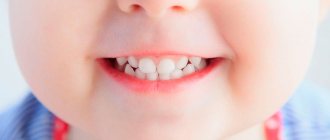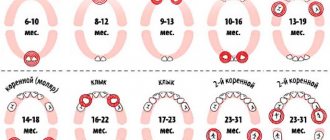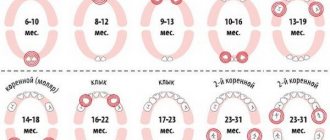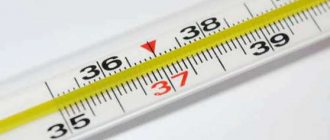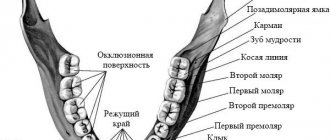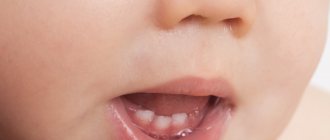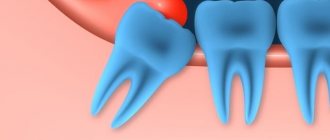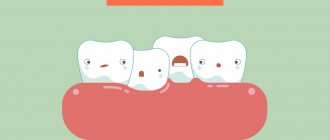26.11.2019
From about six months, the baby begins to be capricious, sleep becomes restless or may be completely absent. In most cases, you can easily diagnose the condition of the baby - teething. But it is precisely this physiological state of the baby that raises a large number of questions among parents. After all, this process is long and not always simple.
Harbingers of teething
Typically, teething begins by six months, about a couple of weeks before that, the “symptoms” of teething begin. All precursors of teething can be classified into two groups.
The first group includes general signs of teething, the second group includes local signs of teething.
Common signs of teething include frequent changes in the child’s mood, whims, poor and restless sleep of the baby, decreased appetite, and at some points the baby may simply refuse to eat for no apparent reason. Babies who are breastfed begin to latch on to the breast more often, one might say they simply “hang” on the chest.
In addition, babies constantly put everything in their mouths, everything that comes to hand. All objects that fall into the mouth are used by him to scratch his gums. Profuse salivation begins a little earlier than whims, but gradually, the amount of saliva released increases. But it is worth remembering that salivation is not always associated with teething. In most cases, the presence of abundant salivation indicates that the salivary glands are functioning properly.
Mothers of toddlers who are breastfed may complain of biting the breast during feeding; the number of feedings also increases, which is especially typical during the night period. Parents may also be concerned about a very specific type of runny nose, which is observed only when the front group of upper teeth, including fangs, erupt. Nasal discharge has a consistency similar to water and does not cause any inconvenience to the child. If green matter appears in the discharge, this indicates a secondary infection and you should consult a doctor.
The second group of signs of teething is local, which will more likely tell whether it is teething or not. When general signs of teething appear, the first thing you need to do is look into the baby’s mouth and carefully examine the gums. In the place where the first teeth should erupt, most often the lower front incisors, redness appears, and the gums may be slightly swollen.
All these symptoms indicate inflammation in the gums, which is a sure sign of teething. Immediately or after some time, you may notice a tooth through the gum that will soon erupt. Gradually, the tooth becomes more and more visible, and the first tooth can already be felt with your finger.
Content
- How wisdom teeth erupt
- Causes of difficulties
- The danger of late eruption
- How can wisdom teeth erupt faster?
- Negative consequences of late eruption
- Ways to get rid of problems
- Medicines
- Home method
- Surgery
Wisdom teeth are rudiments, organs that have lost their significance. They are the last to be cut, pushing the neighboring ones along the way. It is often accompanied by pain, so you have to see a doctor.
How to speed up teething?
Often parents are excitedly waiting for teething, the child already has all the signs of teething, but the teeth themselves are still missing. So what to do? Everything is within normal limits, until the tooth erupts, it goes through a lot of obstacles. And the very first of them becomes bone tissue, the crown of a tooth, a path is paved. After the bone tissue, the tooth must also overcome the mucous membrane, which is more difficult, since this tissue is elastic.
In order to help teething, the child’s saliva contains special substances - salivary enzymes, which “melt” the mucous membrane and thereby contribute to the rupture of the mucous membrane and the appearance of a tooth. In addition, saliva also contains antibacterial agents that help cope with infection, which often appears during teething.
Parents should remember that teething cannot be accelerated in any way. Calcium supplements will not help. They are safely eliminated from the body, and only a small part is absorbed. The baby’s teeth do not erupt due to insufficient calcium; the teething process is much more complicated. Modern dentistry cannot yet accurately answer the question of what exactly causes teeth to erupt. The main theory is that the root of a baby tooth develops; it is its growth that causes the tooth to move. Of course, certain microelements are necessary for growth, but it also takes time for the cells to begin dividing.
Another serious mistake parents make is tearing gum tissue. Under no circumstances should you do this!!!
Firstly, it is worth remembering that it is very painful.
Secondly, it is worth remembering that there is a possibility of injury to the delicate tissues of a tooth that has not yet erupted, and an infection. The only exception is the corresponding operation during the eruption of wisdom teeth, when the so-called “hood” of the mucous membrane is removed in the surgical office.
To facilitate teething, the baby can be given “natural” teethers, for example, a piece of hard bread, crackers, bagels, and all hard foods that can “scratch” the gums. The generation of grandmothers will gladly give the little one a piece of refined sugar. What absolutely cannot be done, for many reasons.
When does a child's molars come out?
Most parents are interested in the question: at what age do children’s molars begin to erupt? The first buds form in the fifth month of pregnancy. The exact timing of their appearance has not been determined and depends on the individual characteristics of the organism. Nevertheless, an approximate scheme for the eruption of molars in children exists. If the appearance of a permanent tooth is delayed for more than six months from the extreme threshold (especially after the loss of a baby tooth), consult a specialist. The doctor will take control of the process and be able to identify complications.
Fever and other “symptoms”
A common complaint from parents is a significant increase in the child's temperature, loose stools, possibly vomiting and the presence of a rash. When contacting a pediatrician, some doctors blame everything on teething, without even trying to look for another reason.
Parents should know that teething cannot produce a high temperature above 38º that lasts more than three days. If the body temperature rises immediately above this figure, then consultation with a specialist is necessary.
Teething has nothing to do with loose stools, cramps, rashes, etc. When these symptoms appear, also with an increase in temperature, it is first necessary to suspect an intestinal infection and other diseases. And you need to urgently consult a doctor.
Many pediatricians and dentists claim that the reason for this condition of the child lies precisely in teething. But in order to refute this statement, it is enough just to understand the mechanism of eruption and the occurrence of temperature. The temperature rises in response to the formation of inflammation in the mucous membrane. But the area of inflammation is so small that the increase in temperature cannot be significant.
Symptoms such as loose stools and fever are more indicators of an intestinal infection; in addition, it is during this period that intestinal infections are most relevant, since the baby puts everything in his mouth.
Each child reacts differently to an increase in temperature, some children do not even notice the increase in temperature, their vital functions do not suffer in any way, the baby has a normal appetite. Another group of children tolerates elevated temperatures very hard; side effects often develop, for example, vomiting, diarrhea, cramps, etc. It turns out that diarrhea and vomiting may be independent manifestations of any disease, or associated with elevated temperature, but not as it is not related to teething.
The appearance of the first teeth is a natural physiological process, which at the same time can become a real test not only for the baby, but also for his parents. In many ways, the child’s condition at this moment depends on the positive attitude, support and attention from the parents. However, we should not forget about the whole arsenal of remedies that will help alleviate the unpleasant symptoms of teething and make this stage in life less exciting and painful.
Crying, whims, increased body temperature, lack of appetite, sleepless nights - all these are constant attributes of the period of dentition (teething) in children. Teething is a natural physiological process that begins at the age of 4-7 months and ends by 3 years, when All 20 baby teeth erupt. Despite the experience of generations, in reality, very few parents know what actually needs to be done to make life as easy as possible for both the baby and themselves.
You can recognize the imminent appearance of a baby tooth by the presence of characteristic signs:
The baby's gums become swollen and salivation increases - typically 4 days before the tooth erupts, on the day of teething, and 3 days after, leading to this 8-day window being called the "teething period".[1]
The child makes intense chewing movements with his gums, trying to get rid of the obsessive itching.
Often, children have a runny nose during the dental period. Nasal discharge and a rare wet cough during teething last no more than 3-5 days and are associated with increased mucus secretion and accumulation of saliva in the upper respiratory tract.
Fever during teething can last 1-2 days, and the child’s body temperature does not exceed 37.4-38⁰C. It is caused by the release of biologically active substances in the teeth growth zone and subsides on its own soon after eruption. However, if the child’s body temperature is above 38⁰C or lasts more than 2 days, you should consult a doctor.
Low-grade body temperature (37-38°C) in children SHOULD NOT be reduced with medication. If your baby's body temperature is above 38°C or lasts more than two days, consult a doctor immediately to rule out infection!
Digestive disorders and loss of appetite are also associated with a large volume of saliva secreted, which stimulates intestinal motility.
The child may become restless and irritable.
How to help your baby when teething
:
. At this moment, surround the child with care and affection - pick him up more often or rock him, thereby calming him down.
For itchy gums, use rubber teethers with liquid contents inside. Pay attention to the composition of the product - it should not contain bisphenol A, latex, PVC, phthalates.
Teethers ease the baby's discomfort from the appearance of the first baby teeth, develop thinking, concentrate attention, and improve fine motor skills of the fingers. Use safe “freezing” - before giving the teether to the child, place the
product in the refrigerator for an hour.
If you have already started feeding your baby, use nibblers (a silicone or mesh container with holes in which chewable foods are placed inside), or offer your baby chilled baby puree, yogurt, etc.
Try to learn a few simple techniques for massaging the gums with your finger to further help your child cope with the painful process of dental treatment.
Focus on safety
With all the introductions, it is, as a rule, almost impossible to overcome the pronounced painful symptoms during teething in a child without taking special medications. To help your baby without risking his health, you must follow the recommendations of your pediatrician. In this case, the choice should be made exclusively in favor of natural and safe products.
To alleviate the baby's condition during teething, parents quite often turn to dental gels based on local anesthetics (lidocaine, benzocaine, choline salicylate), unaware of the possible risks.
Local painkillers in gels have a short-term effect (no more than 1 hour), after which the pain returns. Trying to help their child, parents use gels more often than the safe dosing regimen allows. The natural result of excessive use of dental gels in infants is rapidly increasing intoxication, which can manifest itself as life-threatening symptoms, such as impaired breathing, swallowing, heart rhythm, etc.[2][3]
The Food and Drug Administration (FDA) in the United States opposes the use of lidocaine gels[4] for painful teething in children, warning of the risk of serious side effects.
The FDA has also banned the use of benzoin-based gels for teething in children.[5]
Such local anesthetic drugs numb the child’s gums for 10–20 minutes (in the oral cavity they are washed off with saliva and swallowed by the child), and the risks of their use outweigh the potential effect.
To help your baby without risking his health, you must follow the recommendations of your pediatrician. In this case, the choice should be made exclusively in favor of natural and safe products.
An oral solution based on medicinal plants (chamomile, laconosa, rhubarb) ─ Dantinorm Baby ─ is available in the form of individual dosed containers. Each container contains one 1 ml dose of a sterile solution of the drug, which can be easily dropped into the baby's mouth.
Unlike pain-relieving gels, the effect of Dantinorm Baby begins on average in 10 minutes and lasts on average 8 hours, which, when taken 3 times a day, protects the baby from teething symptoms 24 hours a day.[6] Over the many years of use of Dantinorm Baby throughout the world, not a single case of drug overdose has been reported and there have been no reports of side effects associated with its use.[7]
To date, Dantinorm Baby is the only drug used without restrictions for teething in infants, approved by the Russian Dental Association.
Expert opinion: Larisa Kiselnikova, head of the Department of Pediatric Dentistry, Moscow State Medical University named after. Evdokimova, chief freelance pediatric dentist in the Central Federal District of the Russian Ministry of Health.
“The Dental Association of Russia (StAR) constantly monitors the quality of products and medical products used in dental practice. In 2021, a special commission of StAR conducted an expert assessment of the documentation and analyzed foreign and Russian experience in using Dantinorm Baby. Based on the results of the inspection, the commission confirmed its high efficiency and safety.”
[1] Study Macknin ML, Piedmonte M, Jacobs J, Skibinski C. Symptoms associated with infant teething: a prospective study. Pediatrics. 2000: p. 747-752.
[2]Williams, Gary D., et al. "Salicylate intoxication from teething gel in infancy." Med J Aust 194.3 (2011): 146-8.
[3] https://www.gastroscan.ru/literature/authors/7390
[4]https://www.fda.gov/drugs/drug-safety-and-availability/fda-drug-safety-communication-fda-recommends-not-using-lidocaine-treat-teething-pain-and-requires #:~:text=In%20addition%20to%20causing%20death,or%20it%20is%20accidentally%20swallowed.
[5]https://www.fda.gov/news-events/press-announcements/fda-takes-action-against-use-otc-benzocaine-teething-products-due-serious-safety-risk-lack-benefit
[6] Kazyukova T.V., Ilyenko L.I., Kotlukov V.K. Duration and effectiveness of various medications for pathological symptoms of dentition in infants. Pediatrics. 2019; 98 (2): 133-140.
[7] Instructions for the drug Dantinorm Baby.
How to help your child while teething?
Teething is a very difficult period for babies and parents. The baby is constantly tormented by itching, less often short-term pain, and other unpleasant symptoms. It is worth remembering that there are no 100% sure ways that will help alleviate the baby’s condition. Each baby is individual, and therefore it is necessary to approach this issue individually. Parents need to try different methods and observe the reaction.
Teething in a child most often begins at about six months of age; at this age, the introduction of complementary foods generally begins. Quite often, children refuse complementary feeding and demand their mother's breast. Thanks to this, babies receive not only the necessary nutrition, but also “painkillers”, “sedatives”, etc., which significantly alleviates the child’s condition. It is not recommended to insist on introducing complementary foods, otherwise you can simply provoke vomiting.
Dentists advise giving your child teethers, which can be different. The best characteristics are provided by teethers with fillings that must be pre-cooled. Cold can reduce itching and pain, and “scratching” the gums with a teether promotes faster teething.
You can massage the gums with a gauze pad previously soaked in cold water. Such actions simultaneously relieve itching in the toddler’s gums and clean the oral cavity. Before starting the procedure, parents' hands should be thoroughly washed. The massage should be neat, gentle, with the complete exclusion of pressing and sudden movements.
In order to reduce signs of inflammation, you can wipe your baby’s mouth with solutions of medicinal plants, such as chamomile decoction. You can use the decoction in various ways, give the kids to drink it, or gently wipe the mouth with it, make applications - applying for a while a gauze swab, generously soaked in the decoction.
In pharmacies and widely sold, there are many specialized gels for teething, which contain an anesthetic substance, in most cases it is lidocaine. Before using the gel, you must read the product label. The drug must be used according to strict instructions and in no case more often. Otherwise, it could end badly.
The mechanism of action of such drugs is based on superficial anesthesia (numbness) of the mucous membrane, due to which all unpleasant sensations are reduced and the baby can eat or fall asleep peacefully.
Negative consequences of late eruption of “eights”
The inconvenient location of these teeth for cleaning leads to the accumulation of bacteria and the development of caries, which spreads to neighboring teeth.
Late growth promotes the formation of tumors and cysts.
Maybe:
- Excessive tissue growth that will have to be removed surgically;
- Mechanical displacement of adjacent teeth in the process of freeing up space;
- Violation of the position of the jaws;
- Headache;
- Uneven distribution of load when chewing;
- Formation of traumatic nodes and gingival hood;
- Overhang of the mucous membrane, under which bacteria accumulate.
If measures are not taken in a timely manner, the pathological process will spread, affecting adjacent teeth, cheeks, tongue, chewing muscles, jaw bone and periodontium.

